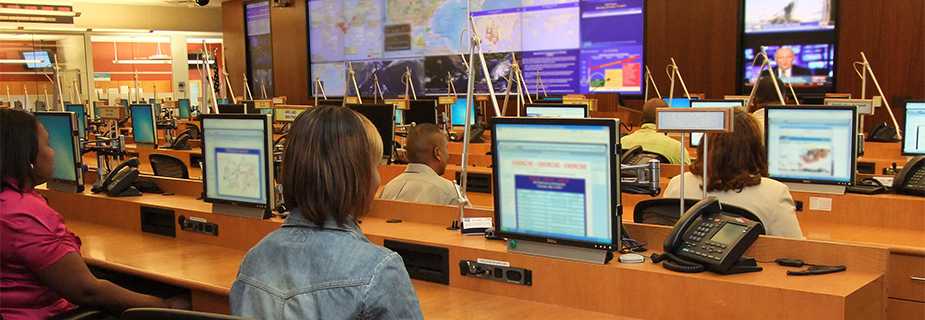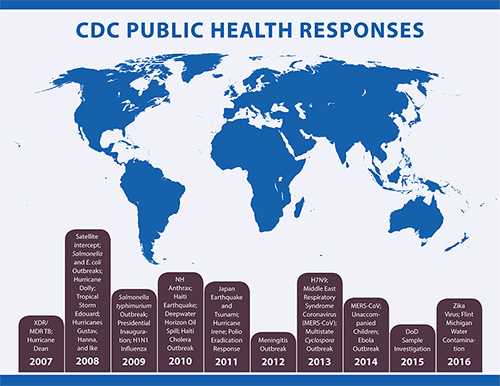Emergency Operations Centers: CDC Emergency Operations Center (EOC)

When CDC gets the call to assist in a public health emergency, the Emergency Operations Center (EOC) is ready to respond.
Across the globe, EOCs are a cornerstone of emergency preparedness and response – a place where highly trained experts monitor information, prepare for known (and unknown) public health events, and gather in the event of an emergency to exchange information and make decisions quickly.
The need for a dedicated EOC in the United States became clear in 2001. During the World Trade Center and anthrax attacks, CDC responded to the emergency using available conference rooms with limited equipment. With support from CDC Foundation, CDC established its first dedicated EOC facility in 2003; the current facility began operations in February 2006.
Today, the CDC EOC brings together teams of highly trained experts and state-of-the-art technology to strengthen our nation’s ability to detect and respond to public health threats.
How we decide when to activate
Even when there is no specific public health threat, the EOC has dedicated staff monitoring information, helping to keep us safe 24/7. These same individuals may be called in to support a response should one arise.
The EOC may be notified about potential public health threats through its watch desk, which fields calls from the public, physicians, and state and local authorities. Notification may also come via public health partner briefings, field operations intelligence, or a worldwide declaration of a Public Health Emergency of International Concern.
The EOC is operated by the Office of Public Health Preparedness and Response (OPHPR) Division of Emergency Operations (DEO). When the DEO first receives information about a potentially widespread threat (like an increase in the incidence of a virus), a team of subject matter experts within the DEO and from across CDC gather to determine whether EOC activation is needed. The team’s assessment is reported to the OPHPR director, who then consults with the CDC director to provide recommendations for action.
The CDC EOC has been activated more than 91% of the time in the last 7 years.
During an Emergency
During public health emergencies, the EOC:
- Deploys scientific experts
- Coordinates delivery of supplies and equipment to the incident site
- Monitors response activities
- Provides resources to state and local public health departments
The Joint Information Center in the EOC coordinates risk communication strategy to develop messages that are timely, accurate, consistent and actionable.
Since its inception in September 2001, the EOC has responded to more than 60 public health threats, including hurricanes, foodborne disease outbreaks, the 2009 H1N1 influenza pandemic, and the Haiti cholera outbreak. In addition to emergencies, the EOC may also be activated for planned events (e.g., presidential inaugurations and Olympics taking place in the U.S.) to monitor for incidents that may affect the public's health. See a comprehensive list of public health responses supported by the EOC since 2001.
After an Emergency
After an exercise or real world response, CDC assesses what worked well, what could be improved, and prepares after action reports and improvement plans. Included in these reports are assessments of how well the response operations met objectives, recommendations for correcting gaps or weaknesses, and plans for improving response operations. CDC's Office of Public Health Preparedness and Response manages the development of these reports.
Emergency response is a continuous process of planning, training, exercising, and evaluation.
Fast facts
- The CDC EOC is staffed 24 hours a day, 7 days a week, 365 days a year.
- The 24,000-square-foot facility seats up to 230 people at a time.
- Between September 2001 and June 2016, CDC activated its IMS for 60 responses
- Approximately 4,000 CDC staff directly participated in the 2014 Ebola outbreak response, making it the largest response in CDC’s history.
- Clinicans, state and local health agencies, and the general public report potential public health threats to CDC through the EOC.
- On October 7, 2013, the CDC became the first federal agency and only public health agency to earn full accreditation of its Emergency Management Program through EMAP.
- Page last reviewed: September 1, 2016
- Page last updated: September 1, 2016
- Content source:


 ShareCompartir
ShareCompartir